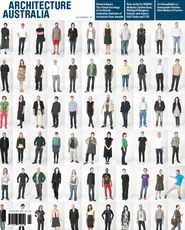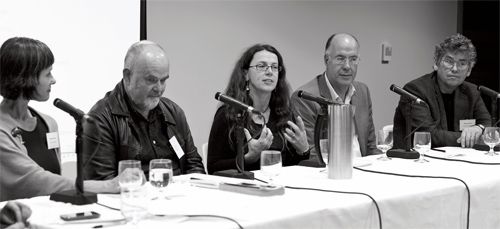
Photography Peter Bennetts.
AA Roundtable 03 – Sustainable Futures: New Modes of Practice – was held on 26 May at the Melbourne offices of ISIS. The topic was a big one; both “sustainable” and “practice” mean many things to many people. To frame the topic we asked each panellist to
Natasha Palich Sense Architecture
Jim GallArchitectus
Ceridwen Owen University of Tasmania
Carey Lyon Lyons
Shane Murray Monash University
Justine Clark Architecture Australia (chair)
Presented in partnership with ISIS
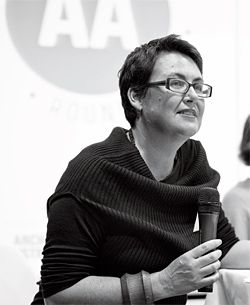
Justine Clark
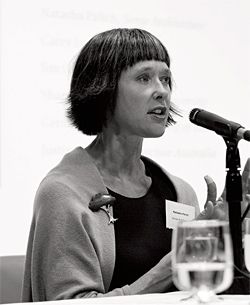
Natasha Palich
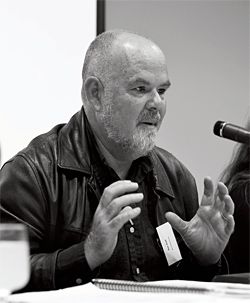
Jim Gall

Ceridwen Owen
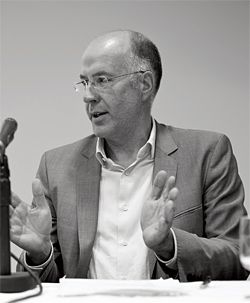
Carey Lyon

Shane Murray
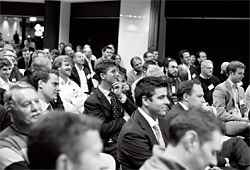
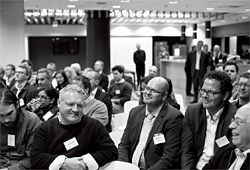
NATASHA PALICH
I am a sole practitioner. I work from home. When I’m working full-time probably I do half architecture, half sustainability consulting and writing. Before I became a mother, I spent time as a volunteer advocate within industry. For me, all these things comprise the practice of architecture.
I think we’re at a turning point. There is now general consensus within the industry about methods of measurement, about what a green building is or isn’t, but we’ve also got buildings maxing out the points under Green Star. So what happens now? We’ve got every point we can get in the Green Star tool, but have we reached sustainability? I don’t think so, and I don’t think that is possible. So where to next? I think it will be about placing that building within a broader system and a wider understanding of how our built environment interacts with our social environments, our economic environments and our natural environments and so forth.
I am intrigued by the idea of positive development and regenerative design – work that makes a positive contribution to other systems: natural, social and/or economic. How is this achieved? I am not sure, but I think it is the next step in the dialogue. We need to move on from a checklist of what is green and what is not towards a discussion about how a building fits within a broader system that includes humans.
JIM GALL
Gall & Medek, which I left a few months ago, is a practice on the ratbag fringe, and that is the line I am going to continue tonight.
I have divided my provocation into three areas: sustainment, design thinking and design practice. Sustainment might be a massive change in the way people think culturally – small “c” culture – our whole deep ideational system. It is like the change to the Enlightenment, we need to change at that scale.
Design thinking. Our practice as architects is “instrumental”. We perform an economic role, we are trained to do particular things in a particular way and, in the broad definition of the word, we seldom actually “think”. A lot of decisions about architecture are made before the architect or any designer is involved.
The environment is often cast as something outside us that we need to sustain. But the environment is outside us, between us and inside our heads. It is a biophysical ecology, social economic cultural ecology and an ecology of mind. Design, as a social and cultural process, needs to be recast. Architects must become directive, people who push towards sustainability.
Design practice. At the moment we design space and materials. We need to start designing in space and in time. We have to imagine what is coming towards us from the future and to design systems that can evolve, that are metabolic and produce places that can develop into that imagined future. The poetry, the beauty of place, will be something that comes from all the other thinking that we do.
To quote Henry Thoreau from 1854, “What I know of architectural beauty I now see I know has gradually grown from within outward, out of the necessities and character of the in dweller, who is the only builder, out of some unconscious truthfulness and nobleness without ever a thought for the appearance.” Our world and our practice will change over the next seventy years in ways that are as unimaginable to us as the cities of today were to Thoreau. Our job as architects is to try and imagine a sustainable future – climate change, peak oil and all that stuff, and to begin to design beautiful places and lives for people for that time.
CERIDWEN OWEN
I am an academic and am engaged in the social construction of architecture more than the physical. My PhD involved interviewing architects around Australia about what sustainability meant to them. It was incredibly revealing. Some saw sustainability as trying to save the environment. That positions architects as environmental vandals no matter what we do – we are always consuming resources and the best we can do is to have a minimal impact. Others had a more expansive definition, integrating the social dimension as a core part of sustainability. I sit more within that social understanding of sustainability.
In 2008 I went to a really depressing sustainability conference. The politicians said, “Aren’t we doing a great job?” and left. Then the experts said, “It’s too late. We are heading towards climate change. Disasters are going to happen.” The question is how we manage these impacts. This leads to the issue of mitigation of environmental impacts versus adaptation of our environments to face these challenges. In terms of mitigation, densification is the dominant narrative, but if we’re talking about adaptation, the argument is that we need looser, flexible cities and less dense environments. I am not arguing for either position, simply suggesting that we need to consider multiple perspectives.
It’s hard to imagine what the future will look like in 40 years time, so I thought I’d start by looking 40 years back. In 1969, the year I was born, the most notable event was the moon landing. Everyone sat glued to their television sets, going, “Fantastic. Imagine the future. We’ll be living on Mars.” That didn’t happen. In the same year, the first data was transmitted on the ARPANET, the forerunner of the internet. That has transformed the way we work. So, the technologies we focus on now are not necessarily the technologies that are going to be really important in the future.
Also in 1969, trouser suits became acceptable everyday wear for women and female workers at the Ford factory won the right to equal pay. This is somewhat laughable now, but it seems absurd that as a society we had the vision, will and technological know-how to launch ourselves into outer space and yet were only beginning to skim the surface of the injustices within our own world. Are we making the same mistakes in thinking about the future?
As for my provocation, I think we should abandon rating systems including Green Star. They lock us into a particular view of the world and they can’t contain the complexity of sustainability. We can argue that they put certain sustainability initiatives on the table, which may not otherwise be considered, but they also exclude options. It’s time we moved beyond checklists. What happens if we get rid of rating systems? What do we replace them with? This might be completely crazy, but let’s consider the Dutch, who handle road safety, for example, by removing traffic signs. Maybe we will be better off without them.
CAREY LYON
At Lyons we prefer to talk about architecture which is sustainable, rather than sustainable architecture. Otherwise we bifurcate architecture, with sustainable architecture ending up in a ghetto with bad sunshades and no windows on the east and west and all those things you get for ticking your boxes. Architecture has to be larger than that. This is my fundamental point: architecture can be sustainable and do other things. So, my first provocation is that before we can talk about sustainable architectural practice we’ve got to sustain architecture. Architecture is not merely a loose assemblage of environmental systems. Many practitioners align sustainability with nature or with biomimicry or with machine, but you can align sustainability with concepts or intellectual ideas, or expressive buildings. We might include sustainability in many ways that are not within current paradigms. But I am also a sceptic about the idea of the paradigm shift – it is a good rhetorical device to convert people, to create true believers in sustainability, which we all need to be, but it is kind of wrong. My view on sustainability, and I am not looking one hundred years into the future I guess, is that it is primarily about changing the technique of architecture – it is about the “how” rather than the “why”.
SHANE MURRAY
I am in the rather remarkable position of starting a new architecture school, the first established in Australia in thirty years. At Monash we investigate how architectural design might contribute to social sustainability. We say that architecture has the potential, through the type of thinking that one develops as a designer, to contribute much more broadly to the issues that we face in contemporary society. We particularly work in housing. As you are probably well aware, the architectural contribution to general housing in Australia is negligible. We are capable of magnificent solutions for dwelling design that we can give to a particular elite in Australian society, but we are practically ignored in the general delivery of housing.
So, one of the things we pursue is how architecture might be more generally engaged. As architects we are detached, partly because of the history of procurement, our role in a hierarchy of professions, and the way financing is arranged, but it is also very difficult for us to articulate what our contribution might be.
At Monash we try to establish how very small elements of design might influence general housing. So we say, what costs nothing in a house? It is where you put the walls. Spatial design of housing is something that architects are experts at. It doesn’t happen in general housing. How might we communicate that? First of all, by articulating our knowledge, which we don’t do. I’d like to see architects working in local governments, in treasury, in the general building industry. I would like to see awards that recognize contributions in general housing. I would like to see architects not only designing fantastic buildings, but also designing the processes that lead to fantastic buildings.
JUSTINE CLARK Perhaps we should begin with the Green Star discussion. I get emails every day proclaiming the first six-star this, the first five-star that – stars have become a huge marketing tool. That might be a good thing, it might be problematic, or it might be both. It does, however, seem to reflect a significant change in what is being commissioned. Do we buy Ceridwen’s proposition that we should dump Green Star, or is there still a productive role for rating systems, and for regulation more broadly?
CL I need to declare an interest – I’m a director of the Green Buildings Council of Australia and I chair its technical steering committee. In defence, the Green Building Council doesn’t suggest that Green Star is the perfect tool, but look at the successes. It didn’t exist before 2002 and now, in Melbourne, no self-respecting developer can put a project into the market unless they have five stars, and five stars version three on the office tool is a pretty significant step. That is incredible, really.
NP I agree. I spent time working at a local council and my job there was to encourage development applications to incorporate sustainability. I saw the full spectrum – from people who didn’t know what sustainability meant to leaders in the field. A big segment of the market just won’t shift without a) regulation and b) the sort of industry drivers that Green Star provides. However, for the top end of the market now is a good time to shift the discussion beyond Green Star. I think we’re going to see a new idea emerge – climate-resilient buildings. This is necessary, but it is not sustainability. We’re talking about adapting so that we can remain comfortable and continue to use our buildings in the way we’re used to. But as this idea of climate-resilience becomes more topical, we shouldn’t lose focus on the ultimate aim – to reduce our impact overall.
JG Rating systems are useful in the short term, but in the end we need major changes in the way people use buildings and live their lives. Tim Flannery talks about ecological disconnection. Green Star is very focused on practice and practical things and technology. Post-Enlightenment, post-Industrial Revolution, we are infatuated with technology. We have to be more humble and use our brains. We need to move our economy from being quantitative to qualitative. The most sustainable thing an architect could do would be to convince somebody not to build a new building, to design something else.
CL Doesn’t sound like a recipe for sustainable architectural practice, though.
JG Why shouldn’t we be paid to give advice? This goes back to what Shane was saying – architects need to come in earlier in the decision making. Economists advise government; planners advise government. But architects don’t talk to governments about strategies for building. Architects need to be part of that, not just making buildings, but shaping the broader built environment.
SM That is the issue. We seem incapable of having any impact at that governance level. In the complex consultative interaction of a building project, it is the architect who draws it all together conceptually and who can deliver the projected vision of application. Yet we have the ludicrous scenario where the business school at Monash is teaching design method. They don’t know what they’re talking about. People confuse systems thinking with design thinking. It is not the same.
CL But you can’t put architects at the top of the tree, in terms of leading on sustainability. It is nonsense. Agreeing with Jim momentarily, it is a wider cultural issue. But I don’t think the cultural change is to live in log cabins and be humble, I think the cultural change is technological. For example, the technology in high-performance glass is extraordinary. But my point is that it’s a partnership, a cultural partnership. If you are serious about reducing a carbon footprint, design is just one part. There is also materials transport, embodied energy through construction and the operational side. We’ve got to do our bit, but it is a little far-fetched for architects to be conducting the orchestra.
JC So, how might we effect change from our position? Is it in low-key, subtle ways?
JG This is where I’m not an architect. My background is environmental science. I started that in 1976 and everyone said, “You’re a dickhead for being interested in the environment.” I did economics, community ecology of plants, animals, mathematics, statistics, anthropology, economics, some subject called major paradigms – a whole range of different things. It was a radical way of teaching a science degree. I’ve spent over thirty years being told no, it is impossible. The world is full of things that are impossible. I’ve also had the fortune over those thirty years of telling people “I told you so”. We have to pull ourselves out of the blinkers of current architectural practice, and take hold of our relational thinking, the ability to deal with complex problems. No-one else has that.
JC Natasha and I also wondered about how architecture might inform and change behaviour.
NP Buildings aren’t the only things that contribute to their impact. It is also the way they are used. Can architecture change people’s behaviour, through its beauty, its technology, its place making? How do we create architecture that overtly and subtly changes behaviour?
AUDIENCE The profession has marginalized itself over time into a profession that deals with lifestyle. It has short-changed its skill base, which is principally about design capabilities that can be applied to anything. I’d like to concentrate on industrial relations. We know that 85 percent of architects work in firms of less than five people. Only 15 percent work at the big end of town. We don’t have an industrial profile, we’ve cut ourselves out of the big-picture discussions. Secondly, if we concentrate on government policy spending, we have to ask, is government really serious about sustainability? Have they got the message, and where is the architectural profession in that discussion? We’re talking about politics, and where are we represented at a national and state level?
JC Natasha, your practice is small, but nonetheless you have aimed to have a big effect. You don’t necessarily have to be in big practice to have a substantial effect.
NP Look, it does get a bit dispiriting at times. But the work I did at council recognized that if you can’t change things at a state level, which is obviously the best place to change, then you try to make changes where you can, and in the capacity you’ve got. My partner is an architect in a very small firm. He works with councils predominantly and he works client by client, taking them on a journey. At first they can’t cope with the technologies or the idea that their atrium might not be airconditioned, but in the second project it becomes a lot easier. So yes, you’ve got to bash away at the politics, but at the same time you’ve got to practise and prove by example, and set your own benchmarks, change them, develop them, exceed them, set new ones and just keep working.
AUDIENCE It is heroic, Natasha. Thank you for your heroism at the small-practice level. Many architects are also valiantly engaged, but in terms of this enormous challenge to the planet, we’ve got to get organized. And the major bodies that represent this profession, such as the Institute of Architects, need to get engaged. We should be in parliament next week making representation about climate change.
CL In fact next week is Built Environment Meets Parliament, which is jointly run by the Australian Institute of Architects, the Property Council of Australia and the Green Buildings Council. These groups spend the day with parliamentarians making a difference politically.
AUDIENCE (Jeff Galway) Sustainability is living now without damaging future generations’ opportunity to live in the same way. All of us can influence that. But what leadership actions and languages can practices undertake now to ensure we move to a sustainable future and a low-carbon built environment?
CL You’ve got to start by being practical. If the world’s leading scientists think that a 60 percent reduction in greenhouse gas emissions by 2050 is a plausible target to stabilize the issues with our atmosphere, then let’s use that as a starting point. Certainly, in our practice, we would say that is the benchmark. Every project we do proves how incredibly difficult that is to achieve and we can’t underestimate what an aggressive target it is. It was talked at Kyoto and then set aside at Copenhagen and it all sounds plausible, but when you’re actually designing buildings it is a massive challenge. So without dreaming too much, I think practice needs to start by looking at the hardcore stuff like that target and water neutrality, which is always a focus in Australia.
AUDIENCE There seems to be an aversion to engaging mainstream media, which governments and the population are very influenced by. The Institute seems invisible, and most people in the street couldn’t name the top five architectural practices in Melbourne – even writers at The Age don’t know who Denton Corker Marshall is. Surely media is the fastest, most effective influence on society? But we are not on the radar as a profession. We gather in small groups and talk among ourselves, but when it comes to commercial projects the building company or the project manager is taking the lead. We’re almost an irrelevancy. How do we turn it around?
CL I think your assessment is a bit pessimistic. Lots of architects are well known in Melbourne politically. I think there is a reasonably high level of engagement in the mainstream media. But if we turn to the issue of sustainability, yes, architects can do more to politicize the issue, but we need to get in behind what the media can do. Last year leading up to the ETS there was pretty extraordinary public debate in the broadsheets about sustainability issues, so it is more of a shock that the politicians would drop it cold. But then the media will drop it cold as well.
SM It is an issue. Where is the new Norman Day? It is not just architecture. A major newspaper has just dropped its art criticism. We can’t sustain a major art school. It’s a real problem. I’m not sure what we can do. Even if most practices are small, we need to make an effort to be public intellectuals, to speak and write to the newspapers. At Monash we’ve just gone into a large research project with the marketing department about how we might communicate spatial design values to a general housing market. General housing is marketed via the cappuccino on the table next to the lake – not a building in sight. The must haves are a double garage, entertainment room, alfresco dining area, et cetera. That’s how housing is sold, not because of how it might contribute to our social and environmental longevity. It’s important that we are starting to think of those things.
NP Maybe newspapers print what they think people want to read. Shane and I worked on a sustainable, affordable house for the mass market. But the market came back and said no, no, no to the ideas we put forward. We need to change market perceptions. Maybe we’ll get more coverage if it is marketable to the general public.
SM This was for an affordable, sustainable prototype for VicUrban. Four firms were selected through a competitive process. The firm I represent was a consortium of academics from RMIT and Monash. In the main, you had to give up ambitions for interesting materials, exotic detailing in this provision.
JG So what? SM Man, let me go. You stole my punchline.
JG I thought you were being precious, sorry.
SM Thanks. Anyway, that is the point. In some ways that was liberating because we had to ask, what can architecture contribute at a cost of adding five grand to a 900-square-metre building rate? For many of us, it was things like having an independent working area that can be accessed separately, or a place where an elderly parent can have their own zone in a very small house, 135 square metres. How you might double program spaces like carports, things like that. They are spatial. They seem quite dull, but they make enormous contributions. So it is the difference between doing one exotic jewel or making one very small contribution 10,000, 100,000 fold. We have to develop that thinking too.
CL Was the irony that it didn’t get published because you had to drop all the glamorous stuff?
SM That is exactly the point. These aren’t sexy because design has been commodified.
NP It is about creating a market.
SM So how do we communicate those values rather than the cappuccino or whatever the benchtop is made out of? We seem incapable of communicating the fundamental contribution of what we do.
AUDIENCE I’m a building owner and frustrated architect. Architecture needs to bring itself back to being about true counsel and leadership. The panel talks about this as a very hard thing. I actually think it is a very easy thing. The property industry is crying out for counsel. All the architecture industry needs to do is to change the way it counsels to industry. It can change that in a generation.
CL I could cite many examples of where that is happening. But the enlightenment of architects is happening at the same speed as the enlightenment of property owners, asset managers and so on. In fact, one of the dilemmas of architectural practices is that they’ll accelerate at slightly different levels and the asset management side of sustainability might become such a driving force that architects will be in the slipstream, as opposed to the current moment where, through Green Star, design is the benchmark and people are still thinking their way through the longer term stuff.
AUDIENCE I believe that human beings have to be sustainably ethical, but I see the Green Star ratings as a shift from petrol engines to electric engines. For example, I am trying to educate my client to pursue an ESD path and the client and I are very happy with the results. But when we started to discuss the depth of these buildings required to get natural ventilation and natural light, suddenly my client says, “That is very beautiful, but I’m not getting my rents out of that. Besides, why don’t we get the five points that we need for the five stars out of the neighbours or the transport next door?” My client will get his five-star building, but how do we educate clients to pursue a sustainable building rather than points to get some rent?
SM I agree with these concerns about star ratings. But I also sit on the Estates Committee, a very new committee at Monash which is responsible for the masterplanning strategy, the overall sustainability strategy and the building procurement strategy for what is probably one of the ugliest campuses in Australia. Green Star is very useful as an institutional tool to try to convince stakeholders to come on board.
JG The most sustainable building I’ve ever worked on was the cheapest building I’ve ever worked on. Why? Because it was half the size that the client expected. How did we do that? With spatial planning, by demonstrating through communication and patience and a public process how it could work. Numerous drawings, hours of discussion and convincing people that you can have what you wanted in a building half the size. That solved all the problems, it solved the economic issues, energy issues. The whole lot just collapses away. And it used a quarter of the materials of a building twice the size. The trouble is that that building wouldn’t have got a Green Star rating because it is all relative to its size.
CO Energy-efficiency is quite simple, but sustainability is quite complex. We need new terms for this, sustainability is completely inadequate and gets us locked into the idea of sustaining the condition that we’re in at the moment, which is not what we want. The frames of reference, the language that we use, is incredibly important to our capacity to think and act differently.
AUDIENCE This morning I met with a member of the Victorian Government Architect’s office to discuss better design outcomes in public transport. We discussed a range of strategies underway that can be developed further. So my comment really is keep going. There is nothing stopping anyone.
AUDIENCE Jim mentioned time as a significant dimension, and Carey mentioned technique. Bringing those together, how might you extend the life of a building from forty to eighty years?
CL My line is that if you design good buildings and people like them they will last. You design crap, it will get knocked over. There is an odd correlation between sustainability and good design. You can call the great Victorian buildings of Melbourne sustainable. They are built to last and they partly last because they are good design.
JG Imagine if we divided the buildings we design into two categories. One is low metabolism, to last two or three hundred years. The other is high metabolism, buildings that are high turnover, and they must be the “cradle to cradle”, as McDonough would say. It is not impossible to design a building to last two hundred or three hundred years, particularly if it can be refitted easily in the future and the materials that are taken away are metabolized. There is an argument that major social buildings should be incredibly precious, designed to work for a long time and to be important to society, and a whole lot of other things are churn.
NP DesignInc’s submission to the 41 Exhibition Street competition worked with that idea. It had a core that would last and layers that would change over time, as needed. It brings up a dilemma though. There is an argument that we need to immediately draw down our carbon emissions as quickly as possible but a core, concrete or heavy mass, is quite energy-intensive in materials.
AUDIENCE Originally human beings built shelter to protect them from the climate. The climate is going to change and it affects everything that we do. How can we make sure that architects and engineers and building owners and the public understand the response to climate and what it is going to do, how do we design those structures to last? Perhaps the answer is to go back to the cave. We came from the cave. Do we have the capacity to respond to the climate?
JG One of the big things architecture can contribute to public debate is to comment on that question and to imagine possible futures.
CL We started the evening with Jim taking us back to the nineteenth century, and then a question took us back to the cave. I’m much more optimistic about the human intellect and what we’ve been able to do. Massive change is needed, but I am optimistic about the stuff happening now and I’m going to maintain my optimism.
SM Despite some of my earlier comments I think there have been lots of small positive changes. We work regularly with the Government Architect’s Office. We have an open door. It is amazing that you can walk into government and suggest that we look at things or do things and they are happy to investigate. It is more about deciding to have that engagement.
JG I’m even more optimistic than Carey. Climate change, peak oil, resource depletion, biodiversity – those are drivers of a massive cultural change in the way we will live. The complexity of those problems is a massive opportunity for the architectural profession because we are used to dealing with complexity. It is an opportunity to generate a whole range of ideas, albeit speculative. They don’t have to be right. It is about a discussion.
CO The difficulty with the future is that there is an awful lot of uncertainty about it. If we just look at the science the writing is on the wall – a 0.4 to 2 degree rise by 2030, 1 to 6 degrees by 2070 and somewhere between 18 and 59 centimetres in sea level rise. I don’t know that we really know what these numbers mean. I do know I have been in a lot of green buildings recently which are overheating – people say, “As soon as we moved in conditions exceeded the design data the environmental experts put in when they were designing it”. It is exceeding projections all the time. We have to put forward propositions in response to questions of time, durability and sustaining the built environment, but these are always uncertain. We need to be flexible and be prepared to challenge what we’re thinking now and go forward cautiously.
NP I agree with Jim and Ceridwen. In part, it is a personal responsibility. You set your own challenges, you exceed them, you test them and you admit where they are wrong and you change them again and continually test them. That is, I think, how we create change, step by step.
This is an edited transcript of AA Roundtable 03, which took place on 26 May at the Melbourne offices of ISIS. We would like to thank ISIS for partnering with us in presenting this event, and the Hatton hotel for accommodating the interstate speakers.

